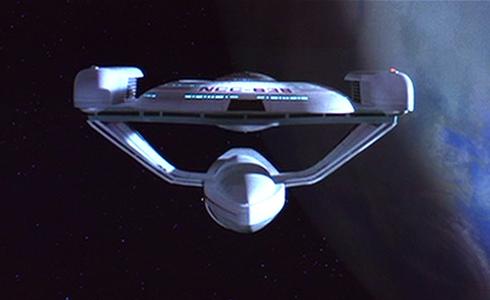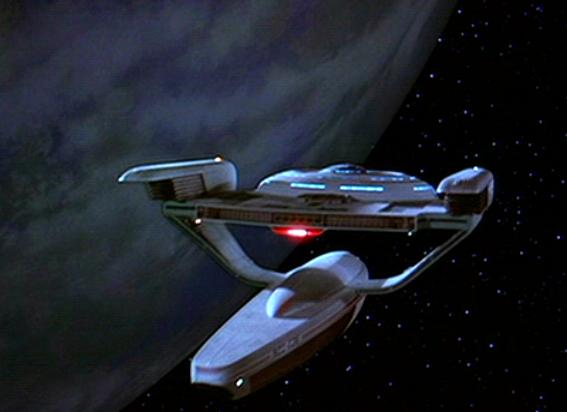Oberth Class
The Oberth class was a mid-sized Federation starship used primarily by Starfleet and civilian scientists alike, as a scout and science vessel, from the late-23rd to the late-24th century.
History[edit]
In service as early as the 2280s, the Oberth-class was designed and used almost exclusively for the study of astronomical phenomena, including data gathering missions on stars and planets, well into the 2360s. (Star Trek III: The Search for Spock, Star Trek VI: The Undiscovered Country; TNG: "The Naked Now", "Hero Worship", "Realm of Fear") By the latter half of the 2360s, these vessels would serve in a number of limited capacities, such as transports and supply ships. (TNG: "The Drumhead", "The Game", "A Fistful of Datas")

In 2358, the Oberth-class USS Pegasus served as a prototype for testing advanced starship technologies. The Pegasus was outfitted with an experimental engine and new weapon systems, some of which were used in the designs for Galaxy-class starships. In addition to this, the Pegasus was the prototype for an illegal Federation cloaking device. (TNG: "The Pegasus")
The Federation continued to construct Oberth-class starships as late as 2363, at such locations as the USSR's Baikonur Cosmodrome. (TNG: "The Naked Now" dedication plaque)
The Oberth was present in several major Federation engagements including the Borg invasion of 2366-2367, where it participated at the Battle of Wolf 359, as well as the Battle of Sector 001 in 2373. (DS9: "Emissary"; Star Trek: First Contact)
The class would slowly be phased out of service during the 2370s, shortly after the introduction of the more advanced Nova-class science vessel. (VOY: "Equinox")
Technical data[edit]
The Oberth-class had an standard crew complement of eighty, but was capable of operating with a minimum crew compliment of five. (ENT: "These Are the Voyages..."; TNG: "The Naked Now", "Realm of Fear")
Physical arrangement[edit]

The Oberth-class design was atypical among Federation starships of the time. The outboard plan of the Oberth's design incorporated a unique split hull design, with an upper primary hull that was composed mainly of the saucer section, which was mounted onto a rear extension that mounts the impulse drive, and warp drive nacelles to either side to the saucer. The secondary hull was connected to the primary hull at the nacelles by reinforced pylons. The secondary hull itself was oblong in shape. (Star Trek III: The Search for Spock, etc.) In all, the Oberth contained thirteen decks. (TNG: "Hero Worship")
Design features of the secondary hull included a docking port located on the port side of the hull. (DS9: "Emissary")
Defensive systems[edit]
More suited for science missions than combat missions, the Oberth-class had minimal defensive systems; it was armed with at least one phaser bank for defense. (Star Trek III: The Search for Spock, Star Trek: First Contact)
They were tactically inferior to such enemy vessels as the Klingon Bird-of-Prey and the Borg cube. (Star Trek III: The Search for Spock; DS9: "Emissary"; Star Trek: First Contact)
As a science vessel, the Oberth-class was designed with specialized shields, which allow them to push through gravitational wavefronts. In conjunction with this feature, the interior bulkheads were composed of victurium alloy to better facilitate shielding. (TNG: "Hero Worship")
Auxiliary craft[edit]
Oberth-class starships were equipped with escape pods, stowing a minimum compliment of two on board a vessel with a crew of five. These escape pods were capable of transporting at least nine personnel at once. (TNG: "Realm of Fear", "The Pegasus")
Interior design[edit]
Main bridge[edit]
Located on Deck 1 of the saucer section, the bridge housed the ship's command center. In general, the Oberth-class had a fairly standard Federation starship floor plan.
Located in the front was the viewscreen, with side-by-side navigator and helm consoles, which are in contrast positioned opposite to the arrangement found aboard Constitution-class starships. The captain's chair is directly aft of the aforementioned stations.
At the rear of the bridge, was a single turbolift-entryway. The primary stations, which were located at either side of the captain's chair included a primary science station to port (pictured, below left) with secondary stations trailing along the wall towards the back of the bridge. Along the starboard side of the bridge was the communications station (pictured, below center). (Star Trek III: The Search for Spock)
The bridge layout during the 24th century included an emergency hatch set in the bulkhead, which could be used to escape from the bridge, into space, during an emergency situation. (TNG: "The Naked Now")
The bridge of the Grissom was a redress of the bridge of the USS Enterprise, altered only slightly to reflect the smaller size of the class. Among the more notable changes are the reupholstered chairs and the placement of center console.
The bridge of the Tsiokovsky was described simply as a "small bridge". The set was only a partial construction, containing a few chairs and consoles, dominated by the view of the open emergency hatch (pictured, above right).
Corridors[edit]
Because of its small size, many of the corridors doubled as auxiliary access points to various parts of the ship.
The anteroom, just outside the bridge, was located at the end of a corridor. This section contained a viewscreen-monitor and the ship's dedication plaque. (TNG: "The Naked Now")
Main engineering[edit]
Engineering was located in the center of the ship, it was where the ship's power systems were controlled and home of the ship's antimatter warp drive chamber and impulse engine controls. (TNG: "The Pegasus")
Science and service sections[edit]
The Oberth-class was equipped with numerous science labs dedicated to scientific study.
One section, located on deck 4 in the saucer section, was a corridor-like chamber that contained a couple of science consoles and adjacent monitors against the wall. Access to the computer core could be interfaced via ODN junction located below the science consoles. The computer core itself was located on deck 13, inside the secondary hull. (TNG: "Hero Worship")
Another section, known as science ops, contained multiple computer consoles, a transport chamber (used for collecting extravehicular objects) and a personnel transporter pad. (TNG: "Realm of Fear")
Accommodations[edit]
Crew quarters found aboard the Oberth-class were not unlike those found aboard other Federation starships. They included a main living area, with an attached bedroom and adjacent bathroom. (TNG: "The Naked Now")
Ships commissioned[edit]
Named[edit]
- USS Biko
- USS Copernicus
- USS Grissom (NCC-638)
- USS Oberth (NCC-602) (prototype)
- USS Pegasus (NCC-53847)
- SS Tsiolkovsky (NCC-53911)
- SS Vico (NAR-18834)
- USS Yosemite (NCC-19002)
Uncertain[edit]
- USS Cochrane (NCC-59318)
- USS Raman (NCC-29487)
Appearances[edit]
- Star Trek films: (4)
- Star Trek III: The Search for Spock
- Star Trek IV: The Voyage Home
- Star Trek Generations
- Star Trek: First Contact
- TNG: (7)
- "The Naked Now"
- "The Drumhead"
- "The Game"
- "Hero Worship"
- "Realm of Fear"
- "A Fistful of Datas"
- "The Pegasus"
- DS9: "Emissary"
- Star Trek films: (4)